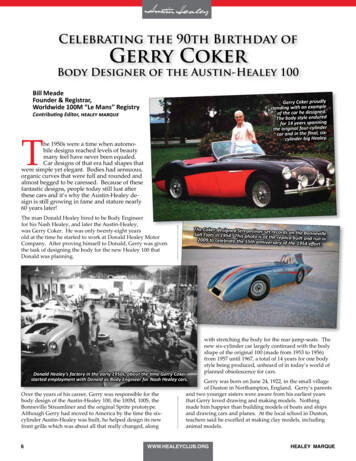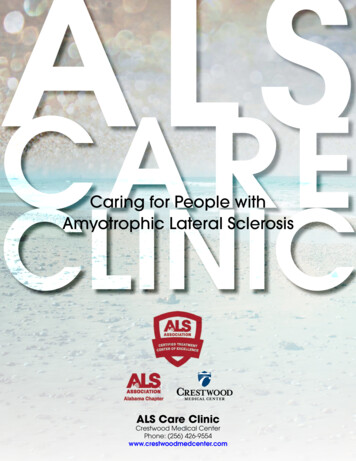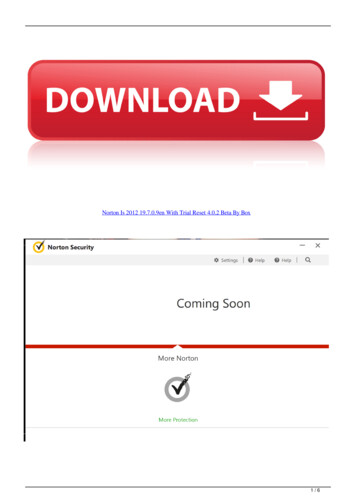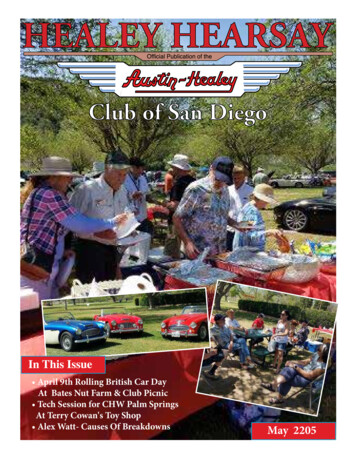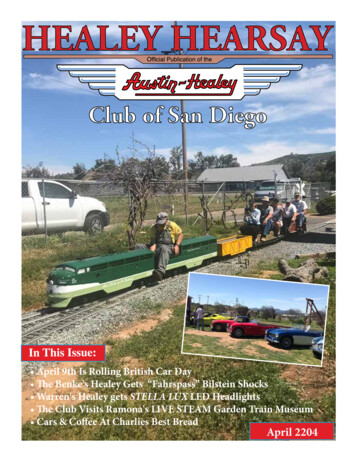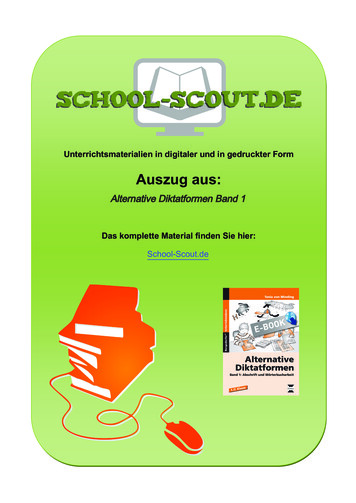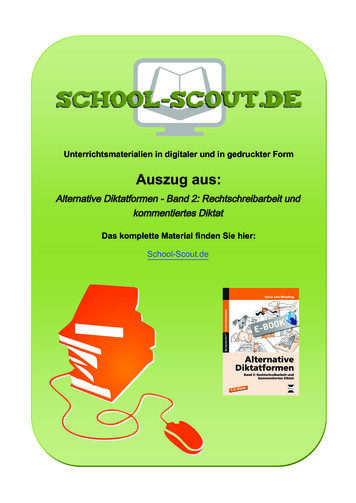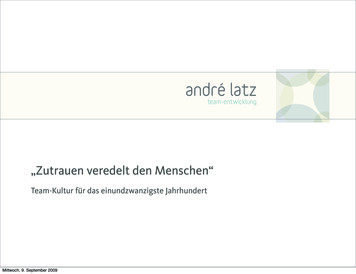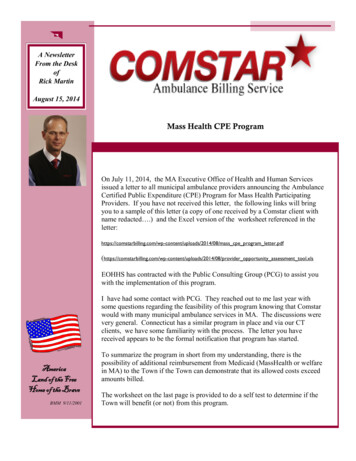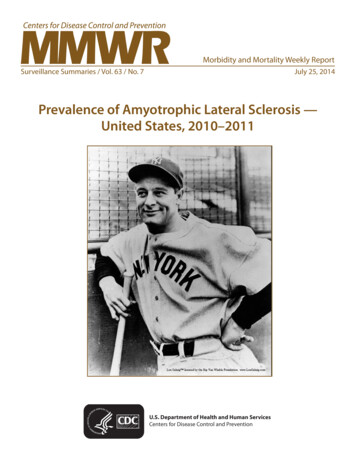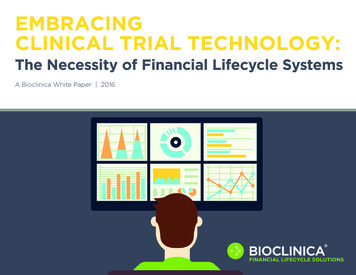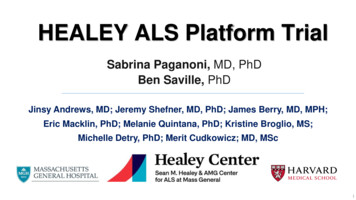
Transcription
HEALEY ALS Platform TrialSabrina Paganoni, MD, PhDBen Saville, PhDJinsy Andrews, MD; Jeremy Shefner, MD, PhD; James Berry, MD, MPH;Eric Macklin, PhD; Melanie Quintana, PhD; Kristine Broglio, MS;Michelle Detry, PhD; Merit Cudkowicz; MD, MSc1
1. WhyNow?2. WhyPlatform? Scientific and Statistical Advantages 3. HEALEY ALS Platform Trial
ALS is the neuromuscular disease with thelargest drug pipeline Over 130 companies in ALS space Thousands of investigators worldwide - many targets“I lost the privilege of working on the human time clock onJanuary 6, 2018 – the ALS clock is a lot faster”Sandy – Person with ALS Platform approach decreases time to finding effectivetherapies3
When will we find first effective therapy?10 TherapiesTested2400 Participants1200 Placebo1600 Participants400 Placebo12TraditionalYears4PlatformYears*Assumes 10% of therapies tested are effective with a 30% slowing in rate of progression4
TraditionalInterventionDisease Therapy APlatformInterventionDiseaseTherapy ATherapy BTherapy C5
Less placebo, more access, more optionsPlaceboControlled24 WEEKSActiveTherapy AOpen LabelExtensionPlaceboEnroll inPlatformTrialActiveTherapy BPlaceboTherapy CActivePlaceboConsentRandomizationShared Placebo
ENDPOINTSPrimary EndpointChange in disease severity - ALS Functional Rating Scale-Revised (ALSFRS-R)Secondary Endpoints1. Change in respiratory function - slow vital capacity (SVC)2. Change in muscle strength - hand held dynamometry (HHD)3. Survival4. Treatment-specific biomarkers as applicableExploratory EndpointsSafety Endpoints7
Exploratory sPBMCs Stem CellsBiomarkers (Blood, Urine, CSF)Speech / Digital
Bringing together a community to launchthe first platform trial for ALS veryRFP fastDue May 8INVESTIGATORSINDUSTRYConcept to LaunchPATIENTS1 YearSITESFDAType C meetingJuly 99
ENGAGED TRIAL DESIGN ie Quintana, PhDKristine Broglio, MSMichelle Detry, PhDBen Saville, PhDSabrinaPaganoniJeremyShefnerEricMacklinNEALS Advisory PanelSenda Ajroud-Driss Americo FernandesEttore BeghiAngela GengeMichael BenatarMatthew HarmsRobert BowserBjorn OskarssonAmy ChenSteve KolbSheena ChewShafeeq LadhaErik PioroJeffrey RosenfeldZachary SimmonsNimish ThakoreDavid WalkJim Wymer10
Experienced Clinical Operations TeamMarianne ChaseNCRI ProjectManagementAlex ShermanNCRI Clinical Trial SystemsAnnette DeMattosNCRI Grants &ContractsHong YuNCRI Data ManagementMegan HallBNI Monitoring &Outcomes trainingEric MacklinMGH Biostatistics Raji BhatJames ChanDerek D’AgostinoCatherine GladdenBrittney HarkeyKatie JentoftLindsay PothierRebecca RandallMelissa RickerAileen ShaughnessyLisa SpagnuoloEric TustisonJason Walker11
54TRIAL-READY SITESCentral1IRB20 years experience; 57 ALS studies with 20K participants already completed including21 industry-sponsored trials12
Patient EngagementPALS/CALSAdvisoryPanel(May 2019)ALSANationalAdvocacyConference(June 2019)“Platform trials maypossibly be the bestthing I have seensince soryPanel(September2019)“Thank you for ensuring thatpatient voices are involved inevery facet of this effort”13
Therapy Selection: Selection CommitteeFrom Healey and NEALS Science Advisory CommitteesRequest for Proposals (RFP) Almost 30 applications from 10 countries- industry and academic Five were selected to enter the platform nowHow to als/research/platform-trial14
Zilucoplan – complement C5 inhibitorVerdiperstat – myeloperoxidase inhibitorCNM-Au8 – gold nanocrystalsPridopidine – Sigma 1 Receptor agonistIC14 – immunotherapy targeting CD1415
Partnership with the FDA: very positive meetingsIND submission 12/2019 July 9, 2019 – FDA Type CMeeting in Washington DC November 5, 2019 – Brought threecompanies together to meet with us and the FDAto finalize the HEALEY ALS Platform trial design.16
Concept to Launch 1 yearRFPDrug SelectionIRBINDProtocol Design Infrastructure Build17
Melanie Quintana, PhDSenior StatisticalScientistKristine Broglio, MSDirector & SeniorStatistical ScientistBen Saville, PhDSenior StatisticalScientistMichelle Detry, PhDDirector, Adaptive TrialExecution &Senior Statistical Scientist18
ALS Platform TrialMASTERPROTOCOLThe trial is governed by a Master Protocol –a common protocol for multiple therapies Defines global rules that govern the therapies beinginvestigated and how participants flow through thetrialTherapy CTherapy BAppendix: The mechanism through which therapiesTherapy Aare added to the platform and attached to the masterprotocol19
20
Master Protocol Overview Primary Endpoint Change in disease severity through 6 months ALS Functional Rating Scale-Revised (ALSFRS-R) 3:1 randomization for each therapy, Active Treatment vs. Placebo Regimen: A therapy being investigated; includes active and matched placeboShared placebo among all regimensUses concurrent and non-concurrent controlsInclusion/Exclusion: Broad ALS patient population Adaptive Trial21
Master Protocol Primary AnalysisBayesian Repeated Measures of ALSFRS-R Model the linear rate of progression in ALSFRS-R for control participants Treatment Effect:Percent Slowing in the rate of progression relative to control Increases power relative to simplified analyses Accommodates additional platform complexities Regimen-level differences of control arm Time-trend effects in rate of progression of control arm Covariates: ALSFRS-R baseline value and pre-slope Mortality: Exponential proportional hazards time to event with sharedtreatment effect22
Shared Control Across RegimensMort. HR: 1.30.8 Different modes of administration Minor differences in inclusion /exclusion Concurrent and non-currently randomized 0.8ALSFRS RALSFRS R Mor t1.0Share ALL controls across all regimensincluding:1.0AnalysisMort. HR: 0.7Power30% SlowingMort. HR: 1 4080Shared Controls*N 160 per Regimen; 3:1 Rand.; Type INumberError:of 2.5%Number of Shared Controls12040120 Shared Controls (3 Reg.)120 80 Shared Controls (2 Reg.)80 0.00.00.20.4 40 Shared Controls (1 Reg.) Differences in controls over time in analysis (time-trend effect) Concurrent vs. non-concurrently randomized controls Potential additional unexplained differences in controls acrossregimens (regimen-specific random effect) Mode of administration Different minor inclusion/exclusion0.60.6Analysis Model accounts for:0.4 0.2 Power 30% Slowing ALSFRS RPower 30% Slowing ALSFRS R 80120Number of Shared Controls23
Clinical Trial Simulation Understand operatingcharacteristics of proposeddesign Optimize design under key trialparameters Quantify Efficiencies of ProposedPlatform Trial over TraditionalPRO-ACTDatabaseRealisticVirtual PatientSimulatorAdaptive DesignPowerOperating Char. OfDesign24
When will we find the first effective treatment? Traditional Drug Development Sequence of fixed 1:1 trials Each N 240 with 120 treated and 120 placebo Lag of 3 months between trials Adaptive Platform Trial Perpetually enrolling max. of 3 regimens Max N 160 with 120 treated and 40 controls Shared controls across regimens10 TreatmentsTested12Years2400Participants1200 onPlacebo10 TreatmentsTested4Years1600Participants400 onPlacebo*Assumes 10% of therapies tested are effective with a 30% slowing in rate of progression25
SummaryPlatform trials can greatly accelerate the path toeffective treatments for ALSThere is strong support for the platform approach regulators, industry, clinician scientists, and patientsThis is a perpetual trial and will continue to testmore interventions until cures are found for allpeople with ALSTo als/research/platform-trial
To als/research/platform-trial
Each N 240 with 120 treated and 120 placebo Lag of 3 months between trials Adaptive Platform Trial Perpetually enrolling max. of 3 regimens Max N 160 with 120 treated and 40 controls Shared controls across regimens 12 Years 2400 Participants 1200 on Placebo 10 Treatments Tested 10 Treatments Tested 4 Years 1600 .
